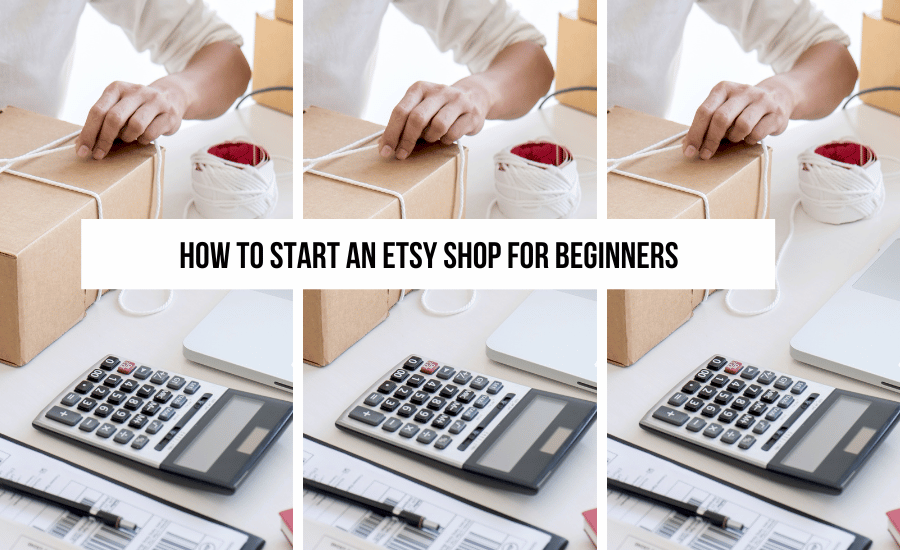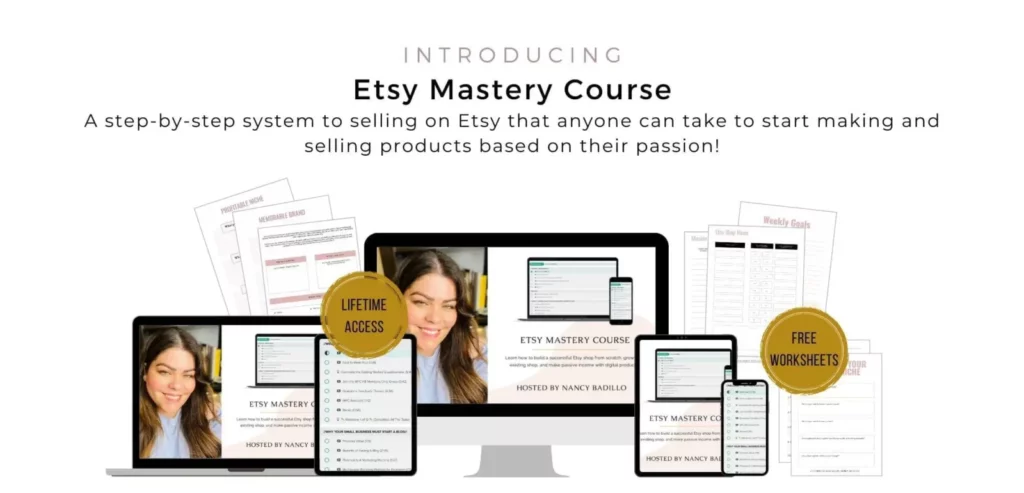Are you a creative person looking to turn your skills into a profitable business? Starting an Etsy shop can be a great way to do just that. Etsy is an online marketplace that provides a platform for creatives to sell their handmade, vintage, and unique items to a global audience. However, starting an Etsy shop can be overwhelming for beginners. With thousands of shops already on the platform, it can be hard to know where to begin.
That’s why we’ve put together this guide to help you start your Etsy shop with confidence. From setting up your shop to creating listings and promoting your products, we’ll cover everything you need to know to get your Etsy business up and running. So, whether you’re a seasoned crafter or a beginner looking to turn your hobby into a business, let’s dive into the world of Etsy and start building your dream shop today!

This blog post is all about how to start an Etsy shop for beginners.
Home > Etsy Biz > How To Start An Etsy Shop For Beginners
DISCLOSURE: This is a sponsored post. Through my links, I may receive a commission if you decide to make purchases at no cost for yourself! Check out our disclaimer for more info on how it works.
Ready to embark on your Etsy business journey but unsure where to begin? Join our free masterclass, where we empower you to start, manage, and scale your Etsy business into a full-time income. With our guidance, 9,000+ individuals have found success, even without a social media presence or email list. Step into the world of Etsy entrepreneurship, and let us guide you to success. Join us now!
Table of contents
- Benefits of starting an Etsy shop
- Researching your niche market
- Creating a unique brand and shop name
- Setting up your Etsy shop
- Creating your product listings
- Product photography and descriptions
- Pricing your products
- Marketing your Etsy shop
- Managing orders and shipping
- Customer service and reviews
- Scaling your Etsy Business
- Tips for success on Etsy
- Conclusion
- Ready To Scale Your Etsy Business?
Benefits of starting an Etsy shop
Starting an Etsy shop can offer many benefits, including the opportunity to turn your creative passion into a profitable business. Here are some of the benefits you can expect:
1. Low startup costs
One of the biggest advantages of starting an Etsy shop is that it requires very little upfront investment. Unlike traditional retail stores, you don’t need to rent a physical space, hire staff, or invest in expensive equipment. All you need is a computer, internet connection, and your creative skills.
2. Wide range of customers
Etsy is a global marketplace with millions of customers from all over the world. This means that you have access to a vast audience that is interested in unique, handmade, and vintage items. With the right marketing strategies, you can reach potential customers who are interested in your products, no matter where they are located.
3. Flexibility and control
As an Etsy seller, you have complete control over your shop and products. You can set your own prices, create your own product listings, and manage your inventory and orders. This gives you the flexibility to work on your own terms and create a business that fits your lifestyle.
Let’s dive deeper into how to start an Etsy shop for beginners.
Researching your niche market
Before you start your Etsy shop, it’s essential to research your niche market. A niche market is a specific group of customers who are interested in a particular type of product. By identifying your niche market, you can create products that appeal to your target audience and increase your chances of success on Etsy. Here’s how to research your niche market:
1. Identify your target audience
The first step is to identify your target audience. Who are the people who would be interested in your products? What are their interests, hobbies, and preferences? By understanding your target audience, you can create products that meet their needs and preferences.
2. Research your competition
The next step is to research your competition. Look at other Etsy shops that offer similar products to yours and see what they are doing. What types of products are they selling? How do they price their products? What marketing strategies are they using? This information can help you identify gaps in the market and differentiate your products from the competition.
3. Conduct market research
Finally, conduct market research to validate your product ideas. This can involve surveying potential customers, testing your products with a small group of people, or analyzing trends in your niche market. By conducting market research, you can ensure that there is demand for your products before you invest time and resources into creating them.
Creating a unique brand and shop name
Once you have identified your niche market, it’s time to create a unique brand and shop name. Your brand is the personality and image of your business, and your shop name is the first thing that customers will see when they visit your Etsy shop. Here’s how to create a unique brand and shop name:
1. Define your brand identity
The first step is to define your brand identity. What values and traits do you want your brand to represent? What is your unique selling proposition, and how will you differentiate your products from the competition? By defining your brand identity, you can create a consistent and memorable image that resonates with your target audience.
2. Choose a shop name
Next, choose a shop name that reflects your brand identity and resonates with your target audience. Your shop name should be easy to remember, easy to spell, and unique. Avoid using generic or overused names that don’t stand out.
3. Create a logo and visual identity
Finally, create a logo and visual identity that reflects your brand. Your logo should be simple, memorable, and recognizable. Use colors and fonts that align with your brand identity and create a consistent visual identity across your Etsy shop and other marketing materials.
Setting up your Etsy shop
Now that you have defined your niche market and created a unique brand and shop name, it’s time to set up your Etsy shop. Here’s how to get started:
1. Sign up for an Etsy account
The first step is to sign up for an Etsy account if you haven’t already. Go to Etsy.com and click on the “Sell on Etsy” button. Follow the prompts to create your account, including your shop name, email address, and password.
2. Set up your shop
Next, set up your shop by adding your shop name, description, and logo. You can also customize your shop banner and avatar to reflect your brand. Make sure to include information about your products, your brand, and your story to help customers connect with your business.
3. Choose your payment and shipping options
Finally, choose your payment and shipping options. Etsy offers several payment options, including credit card, PayPal, and Etsy Payments. You can also choose your shipping options, including shipping rates, delivery times, and shipping carriers.
Creating your product listings
Now that your Etsy shop is set up, it’s time to create your product listings. Your product listings are the heart of your Etsy shop, and they should be optimized to attract customers and convert sales. Here’s how to create compelling product listings:
1. Write a compelling product title
The first step is to write a compelling product title. Your title should be descriptive, concise, and include relevant keywords that customers might search for. Avoid using overly generic titles that don’t stand out.
2. Create a detailed product description
Next, create a detailed product description that includes all the relevant information about your product. This should include details such as the size, materials, colors, and any unique features or benefits. Use descriptive language that helps customers visualize your product and understand its value.
3. Use high-quality product photos
Finally, use high-quality product photos that showcase your product in the best possible light. Use natural lighting, a clean background, and multiple angles to give customers a clear and accurate view of your product. You can also include lifestyle photos that show your product in use and help customers visualize how they might use it in their own lives.
Product photography and descriptions
One of the most critical aspects of creating a successful Etsy shop is having high-quality product photography and descriptions. These two elements work together to showcase your products and help potential customers make informed purchasing decisions. Here are some tips for creating effective product photography and descriptions:
1. Invest in a high-quality camera
Investing in a high-quality camera is essential for creating professional-looking product photos. While you don’t necessarily need to buy the most expensive camera on the market, a good camera can help you capture your products in the best possible light.
2. Use natural lighting
Natural lighting is the best choice for product photography. Avoid using artificial lighting, as it can result in harsh shadows and unflattering colors. Instead, shoot your photos near a window or outside in natural light.
3. Create a consistent background
Creating a consistent background for your product photos can help create a cohesive and professional look for your Etsy shop. You can use a plain white or neutral background, or you can create a custom background that reflects your brand.
4. Write detailed product descriptions
In addition to high-quality product photos, detailed product descriptions are also essential for converting sales. Your descriptions should include all the relevant information about your product, including its size, materials, and unique features. Use descriptive language that helps customers visualize your product and understand its value.
Pricing your products
Pricing your products is one of the most challenging aspects of running an Etsy shop. You want to make a profit, but you also need to be competitive in the marketplace. Here are some tips for pricing your products:
1. Calculate your costs
The first step is to calculate your costs. This includes the cost of materials, shipping, and any fees associated with running your Etsy shop. Make sure to factor in your time and labor costs as well.
2. Research your competition
Next, research your competition to see what they are charging for similar products. This can give you a benchmark for pricing your products and help you identify areas where you can differentiate your products and charge a premium.
3. Determine your profit margin
Finally, determine your profit margin. This is the amount of money you make after deducting your costs from your selling price. Make sure to set a profit margin that allows you to make a profit while remaining competitive in the marketplace.
Marketing your Etsy shop
Once your Etsy shop is up and running, it’s time to start marketing your products to potential customers. Here are some tips for marketing your Etsy shop:
1. Use social media
Social media is a powerful tool for promoting your Etsy shop and connecting with potential customers. Use platforms like Instagram, Facebook, and Pinterest to showcase your products and engage with your audience.
2. Participate in Etsy promotions
Etsy offers several promotional tools that can help you reach a wider audience and increase sales. These include Etsy ads, coupons, and sales. Make sure to take advantage of these tools to promote your products and attract new customers.
3. Optimize your listings for SEO
Optimizing your product listings for SEO can help your products appear higher in Etsy search results and attract more organic traffic. Use relevant keywords in your titles and descriptions, and make sure to fill out all the relevant tags and categories.
Managing orders and shipping
Managing orders and shipping is an essential part of running an Etsy shop. Here’s how to manage your orders and shipping:
1. Stay organized
Staying organized is essential for managing orders and shipping. Use a spreadsheet or other tracking tool to keep track of your orders, shipping dates, and tracking numbers.
2. Communicate with customers
Communicating with customers is essential for building trust and ensuring a positive customer experience. Keep customers updated on the status of their orders and respond promptly to any questions or concerns they may have.
3. Choose the right shipping options
Choosing the right shipping options can help you save time and money while providing a positive customer experience. Consider using Etsy’s shipping labels, which offer discounted shipping rates and automatic tracking information.
Customer service and reviews
Providing excellent customer service and responding to customer reviews is essential for building a successful Etsy shop. Here’s how to provide great customer service:
1. Respond promptly to customer inquiries
Responding promptly to customer inquiries can help build trust and ensure a positive customer experience. Make sure to respond to customer messages within 24 hours.
2. Resolve any issues quickly
If a customer has an issue with their order, make sure to resolve it quickly and efficiently. This can help turn a negative experience into a positive one and build customer loyalty.
3. Encourage customer reviews
Encouraging customer reviews can help build social proof and attract new customers to your Etsy shop. Make sure to include a request for a review in your order confirmation emails and provide excellent customer service to ensure positive reviews.
Scaling your Etsy Business
Once your Etsy business is up and running, you may want to consider scaling your business to reach even more customers and increase your profits. Here are some tips for scaling your Etsy business and how to start an Etsy shop for beginners:
1. Expand your product line
Expanding your product line can help you attract new customers and increase your sales. Consider adding complementary products or expanding into new product categories.
2. Hire help
If your Etsy business is growing quickly, you may need to hire help to keep up with demand. Consider hiring a virtual assistant or outsourcing certain tasks to free up your time and focus on growing your business.
3. Diversify your sales channels
Diversifying your sales channels can help you reach new customers and reduce your dependence on Etsy. Consider selling your products on other platforms like Amazon, eBay, or your own website.
Tips for success on Etsy
Here are some additional tips for how to start an Etsy shop for beginners:
1. Be patient
Building a successful Etsy shop takes time and patience. Don’t expect to see instant results, and be prepared to put in the work to grow your business over time.
2. Stay on top of trends
Staying on top of trends in your niche market can help you create products that are in demand and appeal to your target audience. Follow industry blogs, attend trade shows, and keep an eye on competitors to stay up to date.
3. Keep learning
Finally, keep learning and improving your skills. Attend workshops, read books, and take courses to stay up to date on the latest trends and techniques in your industry.
Conclusion
Starting an Etsy shop can be a great way to turn your creative passion into a profitable business. By following the steps outlined in this guide, you can set up your Etsy shop with confidence and start selling your products to a global audience. Remember to stay patient, stay on top of trends, and keep learning to achieve success on Etsy. I hope this blog post was all about how to start an Etsy shop for beginners.
Ready To Scale Your Etsy Business?
If you’re considering starting your own Etsy store but unsure about which products to offer, my signature course, the Etsy Mastery Course, is your ultimate guide. Learn how to start, manage, and scale your Etsy business to a full-time income.


+ show Comments
- Hide Comments
add a comment